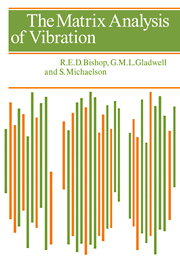Book contents
- Frontmatter
- Contents
- Preface
- Chapter 1 Notation and elementary properties of matrices
- Chapter 2 The vibration of conservative systems having a finite number of degrees of freedom
- Chapter 3 Linear equations
- Chapter 4 Further development of the theory of conservative systems
- Chapter 5 Damped forced vibration
- Chapter 6 Continuous systems
- Chapter 7 The solution of linear equations and the inversion of matrices
- Chapter 8 Iterative methods for characteristic value problems
- Chapter 9 Direct methods for characteristic value problems
- Appendix
- Answers to examples
- Index
Preface
Published online by Cambridge University Press: 24 November 2009
- Frontmatter
- Contents
- Preface
- Chapter 1 Notation and elementary properties of matrices
- Chapter 2 The vibration of conservative systems having a finite number of degrees of freedom
- Chapter 3 Linear equations
- Chapter 4 Further development of the theory of conservative systems
- Chapter 5 Damped forced vibration
- Chapter 6 Continuous systems
- Chapter 7 The solution of linear equations and the inversion of matrices
- Chapter 8 Iterative methods for characteristic value problems
- Chapter 9 Direct methods for characteristic value problems
- Appendix
- Answers to examples
- Index
Summary
The introduction of high-speed electronic computers into engineering has opened the way for the solution of vibration problems of great complexity. One of the most suitable ways of expressing a problem for computational analysis is to use matrices. This book is concerned with the matrix formulation of the equations of motion of vibrating systems, and with techniques for the solution of matrix equations.
The purely computational side of practical vibration analysis naturally divides into two parts. The first is the construction of a mathematical model for the vibrating system, that is the setting up of equations governing its motion. The second is the process of solving the mathematical equations and extracting the properties of the solutions. This book is mainly concerned with the second part of the analysis. It will be assumed, on the whole, that the reader is acquainted with the various ways of setting up the equations of motion of vibrating systems.
This book can be regarded as a sequel to an earlier volume. The first, as its title suggests, is concerned mainly with the mechanics—the physical side—of vibration: this book is concerned more with the mathematical aspects of the subject. The connection between the two books is loose and they may be read independently of each other.
The fact that the book is concerned with the mathematical side of vibration theory, rather than the physical, throws emphasis on examples.
- Type
- Chapter
- Information
- The Matrix Analysis of Vibration , pp. ix - xPublisher: Cambridge University PressPrint publication year: 1979



